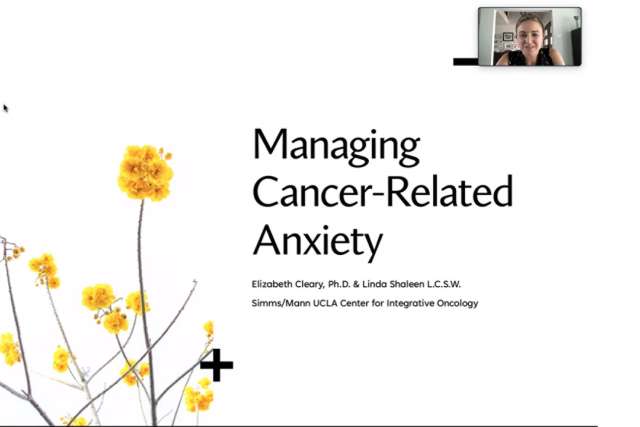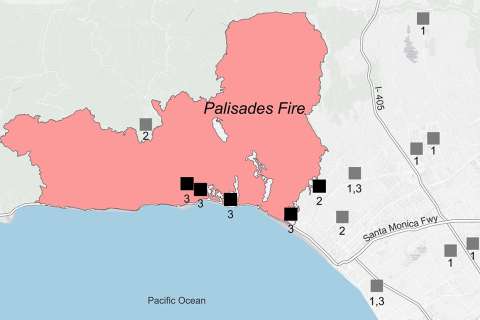Anxiety and worry are part of any cancer diagnosis. What will treatment be like? Can we afford it? How will this affect my family, work and responsibilities? How will this change my life?
The Simms/Mann-UCLA Center for Integrative Oncology is dedicated to providing psychosocial support for people diagnosed with cancer and their loved ones. In addition to counseling, support groups, spiritual care and nutrition guidance, the center offers online workshops to support people in getting better sleep, dealing with grief and coping with the anxiety and worry that come with cancer.
“No set of strategies that we offer could eliminate worry that is grounded in a significant life event such as a cancer diagnosis,” said Elizabeth Cleary, PhD, a clinical psychologist with the Simms/Mann Center and co-leader of the recent workshop “Turning Down the Volume on Worry: Managing Cancer-Related Anxiety.”
“But we do want to offer hope in the form of a range of strategies that we know, that research shows, can really help lessen the burden of worry.”
The American Psychological Association defines anxiety as “an emotion characterized by feelings of tension, worried thoughts and physical changes like increased blood pressure.” Worry is a cognitive process, Dr. Cleary added, based on thinking about the future and anticipating danger.
Anxiety and worry trigger the autonomic nervous system’s sympathetic response, which prepares the body to fight or flee. Heart rate increases, senses heighten, muscles tense. This is helpful if there’s a tiger chasing you, but far less useful if you’re sitting in a doctor’s office waiting for test results.
The opposite of the sympathetic nervous system response is the parasympathetic response, also known as the rest-and-digest state. The parasympathetic nervous system allows breathing and heart rate to slow down and muscles to relax. Tapping into this state helps ease anxiety and panic.
Dr. Cleary and Linda Shaleen, LCSW, shared the following tools for managing cancer-related anxiety:
Breathe: “The one way we can communicate with our parasympathetic nervous system, with that automatic rest-and-digest state, is through our breath,” Dr. Cleary said.
One strategy is diaphragmatic breathing, or deep-belly breathing, that involves engaging the diaphragm muscle at the base of the lungs. Breathing deeply in this way, where the breath is felt deep in the abdomen, tells the body there is no current danger, no need to fight, flee or freeze. “This actually turns on the brakes so we can be in that calm, relaxed state,” Dr. Cleary said.
Move: “Exercise is a powerful tool to turn down the volume of anxiety,” Dr. Cleary said, adding that it also can help ease fatigue, which is one of the most common side effects of cancer and its treatment. Exercise often naturally modulates our breathing. And movement need not be vigorous to help with anxiety. Walking, yoga, stretching, gardening and cooking are all excellent forms of activity, Dr. Cleary said: “Anything that is more physically active really gives our body an outlet for some of that physiological activation.”
Mindfulness: Much of our suffering comes from worrying about things that might happen in the future or ruminating about things that have happened in the past, Shaleen said. Mindfulness is the practice of non-judgmental awareness of the present moment. It’s a practice that builds awareness, she said, which allows us to notice our thoughts, feelings and physical sensations as they arise and subside. This allows us to respond with less attachment to various thoughts and sensations and more easily release them.
Thought exploration: Human beings are hardwired with negativity bias, Shaleen said, which means we tend to notice and recall negative things more readily. These biases make us prone to thought traps “that may only account for part of the picture, not the whole picture,” she said. These patterns include catastrophizing (predicting the worst), black-and-white thinking that makes no room for nuance, mind reading (deciding we know what others are thinking even when they haven’t told us), treating feelings as facts and ignoring good things that happen.
It can be helpful to notice and counter these biased thought traps by asking ourselves questions, such as: What evidence do I have for this thought? Am I overestimating the possibility of this occurring? Can I run these assumptions by a friend for feedback? Am I basing my thoughts on facts? Am I seeing this as black or white, when there are some possible outcomes that might be in the middle? What advice would I give to a friend who came to me with this concern?
Cognitive diffusion: “Rather than treating our thoughts as true, we can see our thoughts as just thoughts — the content that our mind is constantly producing,” Dr. Cleary said. “We can learn to observe our thoughts without needing to react to them or respond to them.”
Two helpful metaphors for this are the email inbox and passengers on a bus, she said.
We likely receive multiple emails every day, but not all of them deserve the same amount of attention. Some require thorough reading and a thoughtful response, some can be simply skimmed and others are clearly spam. Dr. Cleary suggested applying this “filtering” approach to our thoughts: Recognizing those that have valuable content and tending to them, but labeling other thoughts as spam that don’t need further attention or follow-up.
Another approach is to consider thoughts like passengers on a bus. In this metaphor, we are the driver of the bus, going down the road of our life. The passengers, who come on and off the bus as we go, represent our thoughts, sensations, urges and feelings.
“Some passengers are quiet, others might yell, make a mess, or ask us to drive off course, but we are the ones at the wheel,” Dr. Cleary says. “Our job is to stay the course and go in the direction of what we value.”




